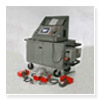VSR TECHNOLOGY's vibratory stress relief equipment and systems are used for metal stabalizing in a variety of industries including manufacturers of automotive and aerospace tooling, paper mill machinery, mining, hydro-turbine and power generation equipment, pumps, gear boxes, machine tool building and repair, and job shop manufacturing of large precision components and parts.
Vibratory stress relief is a non-thermal stress relief method that employs tightly controlled, high force, mechanical vibration energy to redistribute internal stresses in castings, forgings, and welded structures, parts, and components. Vibratory stress relieving significantly reduces dimensional instability during machining, improves fatigue life, and minimizes distortion during assembly, test loading, transport, and field usage of a wide array of metal components.
Vibratory Stress Relief Historical Overview

Rudimentary forms of vibration were used in an attempt to stabilize metal parts almost two centuries ago. "Hammer relaxation", the art of stress reduction through the application of repeated hammer blows to generate high amplitude, gradually decaying vibration, is but one example of early efforts at vibration induced metal stabilization. Other uncontrollable, unpredictable, and too slow efforts to employ vibration included the early foundry practice of dropping castings from considerable height into a sand pile, the "natural aging" or curing process of storing work pieces outdoors for 6 to 18 months to allow the metal to expand and contract with the daily changes in ambient temperature, as well as peening, a process which, although well-accepted as a method to preclude stress corrosion, is only marginally effective as a method of stress relief.
Metal Stabilization Job Stories & Reports
ALLVAC
This report describes using the vibratory stress relief process on a fabricated 20 foot diameter inlet with dome cover assembly made of 304 stainless steel. This assembly was welded to a 28 foot diameter vacuum furnace. The fit between the dome and inlet flanges, responsible for the integrity of the furnace's seal was a major concern to ALLVAC, and VSR Technology's vibratory metal stabilization process was chosen to stress relieve the assembly prior to welding it to the furnace.
INGERSOLL MACHINE TOOLS INC
To date, INGERSOLL has produced milling machines capable of machining parts over 100 feet in length. Stress relieving their machines' components can be a challenge. The VSR process was used to stabilize a 59 foot long milling machine gantry. Stress relieving the work piece both before and after rough machining (total time < 4-hours) resulted in a dimensional accuracy of 0.0036" over the entire length, and only 0.0018" in the critical center portion of the component where spindle travel occurs.
VOITH SIEMENS
A manufacturer of hydro-turbine equipment used for power generation received an order to replace 4 tons of cavitated cast steel in 100,000 lb. bottom ring assembly, they chose the vibratory stress relief process to assure stability throughout fabrication and machining. The result was not only an 80% to 90% reduction of distortion at a critical stage in the fabrication process, but also a considerably more stable work piece during final machining.
Vibratory Stress Relief Technical Information
Vibratory Stress Relief Technical Library
A comprehensive directory of papers and works, the VSR technical library offers the industry’s most comprehensive, definitive, and pioneering works in the field of vibratory stress relief.
Vibratory Stress Relief Products

After six decades of evolution, vibratory stress relief has moved to center stage as a proven method of metal stabilization. VSR Technology offers the VSR-8000 vibratory stress relief system, providing computerized treatment and automatic treatment data archiving. The system uses resonate vibration to take full advantage of both resonance peak growth and/or shifting type responses that occur during effective metal stress relieving.